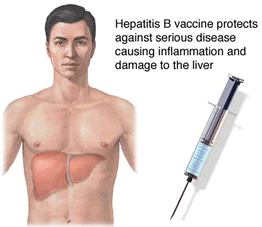Hepatitis
B Vaccination Dramatically Lowers Prevalence among U.S. Children
 |
 |
 |
 |
| SUMMARY:
Children and adolescents in the U.S.
today have a very low likelihood of hepatitis B
virus (HBV) infection thanks to widespread vaccination,
according to an epidemiological study described
in the March
1, 2011, Annals of Internal Medicine.
Many adults remain vulnerable, however, underlining
the importance of vaccination for at-risk groups. |
|
 |
 |
 |
 |
By
Liz Highleyman
 George
Ioannou from the Veterans Affairs Puget Sound Health Care
System in Seattle and colleagues looked at data from a periodic
national household health survey to estimate the prevalence
of hepatitis B infection, exposure, and immunity. George
Ioannou from the Veterans Affairs Puget Sound Health Care
System in Seattle and colleagues looked at data from a periodic
national household health survey to estimate the prevalence
of hepatitis B infection, exposure, and immunity.
The study sample consisted of 39,787 participants age 2
years and up who took part in the National Health and Nutrition
Examination Survey (1999 to 2008), a representative, cross-sectional
household survey. NHANES participants were interviewed about
their health status and underwent physical exams, including
blood tests. Being a household survey, it did not include
military personnel, prisoners, homeless people, or people
in nursing homes and other group care facilities.
Among people age 6 or older, chronic HBV infection was defined
as detectable serum HBV surface antigen (HBsAg). Past exposure,
or cleared infection, was determined by presence of serum
antibodies against hepatitis B core antigen (anti-HBc);
a majority of people acutely infected with HBV naturally
clear the virus without treatment, conferring immunity against
future infection. Infant immunity was defined as presence
of antibodies against HBsAg among children age 2 years.
(See
this chart for more details on HBV testing.)
Results
 |
Among
people age 6 years and older, 0.27% had chronic HBV
infection, corresponding to approximately 704,000 individuals
nationwide. |
 |
4.6%
showed signs of exposure to HBV, corresponding to about
11,993,000 people. |
 |
Current
and past infection were very uncommon among children
and adolescents age 6 to 19 years. |
 |
69%
of children at age 2 were immune to HBV, mostly due
to vaccination. |
 |
Adults
-- including groups at high risk for infection -- had
much lower rates of immunity.
|
Based
on these findings, the researchers concluded, "A cohort
of children and adolescents is growing up in the United States
with high rates of immunity against HBV and very low rates of
infection."
They noted that the current estimated rates of chronic HBV infection
(0.27% vs 0.42%) and exposure with cleared infection (4.6% vs
5.1%) were lower than those reported in a previous survey during
1988-1994.
"Vaccination of high-risk adults should continue to be
emphasized," they recommended.
The U.S. Centers for Disease Control and Prevention (CDC) recommends
hepatitis B vaccination for all infants at birth, children and
adolescents who were not vaccinated as infants, health care
professionals and emergency personnel, injection drug users,
residents and staff of correctional facilities and group homes,
sexually active teens and adults, men who have sex with men,
sex partners and household members living with an HBV-infected
person, and travelers to countries where hepatitis B is common.
Investigator affiliations: Veterans Affairs Puget Sound Health
Care System and University of Washington, Seattle, WA.
3/15/11
Reference
GN
Ioannou. Hepatitis B Virus in the United States: Infection, Exposure,
and Immunity Rates in a Nationally Representative Survey. Annals
of Internal Medicine 154(5): 319-328 (abstract).
March 1, 2011.
|
